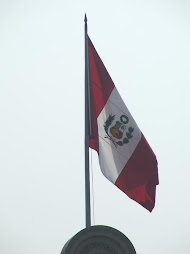A few days before my family's visit, a baby was born in my host family. Roxana and Raul (Gloria's brother) gave birth to a baby girl. After meeting my beautiful sister Jessica (who during her visit was called “Princess,” “Barbie” “Really White,”-which is a good thing, etc), my host family fell in love with her. They are still talking about her and how beautiful she is. In fact, her legacy will live on for quite a while because the new baby was named Jesica! This is the second Peruvian baby named after a family member. In Julcan, if the baby was a girl, it was going to be called Rebecca Marcia (Marcia, my mom, and I got left out because it was a boy.) The new baby was named Steven, in honor of my dad, who the family never had even met.
I'm not quite sure why they like us, or at least our names, so much. It's flattering, I guess. Peruvians are very enamored with all aspects of North America and its culture. They are always asking about it and curious about life there. For example, I have heard WAY too much about Michael Jackson's death in the past week. I'm not sure how big it is in the news in the US, but Peruvians want to talk all about MJ with me.
Anyway, back to baby Jesica. As I've talked about in previous entries, a huge part of Peruvian culture is having madrinas and padrinos (godparents) for EVERYTHING. I've been a madrina for an elementary school graduation, a high school graduation, an inaguration, and, now something new. I was asked to be Jesica's madrina for her earpiercing and first nail cutting. That sounds as weird and confusing to you as it did to me when I was asked to be the madrina. It is an honor to be someone's madrina, but I didn't really understand. Well, I had to do exactly what it sounds like. I pierced the baby's ears! And then cut her nails. It is tradition that a chosen godparent cuts the fingernails for the first time for all babies. And for girls, a godparent pierces the baby's ears. I freaked out a little bit, when I saw the earrings the mom's hand and she asked me to just stick them in. I declined at first, because I would NEVER do that sort of thing in the States. But they begged and pleaded and I decided to embrace yet another bizarre part of the culture. So I pierced Jesica's ears, and then cut her little nails; she barely even cried. And now I am the godmother of her ears and fingernails.




















































